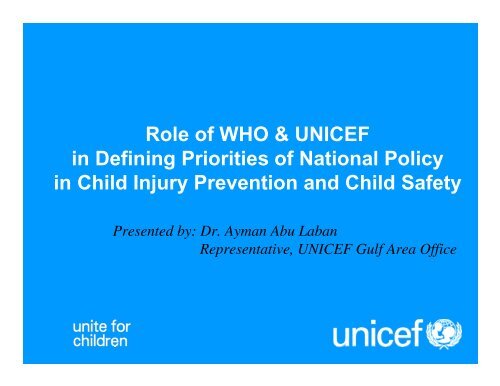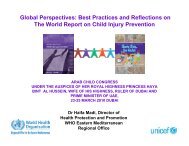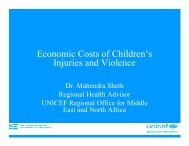H.E. Dr. Ayman Abu Laban. - Arab Children Health Congress
H.E. Dr. Ayman Abu Laban. - Arab Children Health Congress
H.E. Dr. Ayman Abu Laban. - Arab Children Health Congress
Create successful ePaper yourself
Turn your PDF publications into a flip-book with our unique Google optimized e-Paper software.
Role of WHO & UNICEF<br />
in Defining Priorities of National Policy<br />
in Child Injury Prevention and Child Safety<br />
Presented by: <strong>Dr</strong>. <strong>Ayman</strong> <strong>Abu</strong> <strong>Laban</strong><br />
Representative, UNICEF Gulf Area Office
Outline<br />
‣ Child Injuries:<br />
• A Major Public <strong>Health</strong> Concern<br />
• A Global Picture<br />
• The Situation in the UAE<br />
• A Comparison<br />
• Missing from Child Survival Strategies<br />
‣ Efforts to Influence National Policy<br />
‣ Stakeholders<br />
‣ Priorities of National Policy<br />
‣ Challenges in Child Injury Prevention<br />
‣ A Call for Action<br />
‣ International Contributions<br />
‣ The World Report on Child Injury Prevention<br />
‣ The Preventability of Child Injury<br />
‣ Injury Prevention Strategies and Approaches<br />
‣ The Sweden Experience
Child Injuries: A Major Public <strong>Health</strong> Concern<br />
• Injury and violence kill approximately 950,000 child and young<br />
people under the age of 18 each year<br />
• Unintentional injuries account for almost 90% of these cases,<br />
that is hundred children dying needlessly every hour of every<br />
day Source: WH O (2008), Global Burden of Disease: 2004 update.<br />
• Patterns of child injury are influenced by age, gender,<br />
socioeconomic and environmental factors.
Child Injuries: A Global Picture<br />
Leading Causes of Death in <strong>Children</strong>, Both Sexes, World 2004:
Child Injuries: The Situation in the UAE<br />
Reported Child Death in UAE by Age Group and Type of Injury:<br />
Source: Accident and Emergency Nursing (2007) 15, 228–233
Child Injuries: A Comparison<br />
Injury Mortality among <strong>Children</strong> in UAE Compared to Other<br />
Countries (1991-1995):<br />
A. Bener et al. 2007, Trends in childhood injury mortality in a developing country: United <strong>Arab</strong> Emirates. Accident and Emergency Nursing 228-233
Child Injuries: Missing from Child Survival<br />
Strategies<br />
• Child injuries have been neglected for many years, and are largely<br />
absent from child survival initiatives on the global agenda<br />
Programs targeting child survival<br />
Child injury and violence prevention programs need to be<br />
integrated into child survival broad strategies to avoid the loss of<br />
large investments in child health care
International Contributions
The World Report on Child Injury Prevention<br />
The World <strong>Health</strong> Organization (WHO) and the United<br />
Nations <strong>Children</strong>’s Fund (UNICEF) recognize injuries as<br />
one of the leading killers of children.<br />
UNICEF and WHO and other partners have set out to<br />
elevate child injury to a priority by launching the :<br />
•World Report on Child Injury Prevention (directed at<br />
researchers, public health specialists, practitioners and<br />
academics)<br />
•Summary of the report containing the main messages<br />
and recommendations (directed to policy makers and<br />
development agencies)<br />
•A version aimed at children
The Preventability of Child Injury<br />
• Child injuries can greatly be prevented or at least controlled<br />
• For each area of child injury there are proven ways to reduce both the<br />
likelihood and severity of injury
Injury Prevention Strategies and Approaches<br />
• Legislation and enforcement<br />
• Product modification<br />
• Environmental modification<br />
• Supportive home visits and<br />
promotion of safety devices<br />
• Education, skills development and behavior change<br />
• Community-based projects<br />
• Emergency, medical care, and rehabilitation
The Sweden Experience<br />
• Many high-income countries have been able to reduce their<br />
child injury deaths by up to 50% over the past three decades by<br />
implementing multi-sectoral, multipronged approaches to child<br />
injury prevention.<br />
• In Sweden, rather than organizing one central campaign, their<br />
efforts were directed at influencing existing groups to pursue<br />
child safety within their own sphere of interest and expertise.
The Sweden Experience<br />
Trends in Child Injuries, (1969–1999)
Efforts to Influence National Policy<br />
UNICEF seeks to reduce injuries among children and young people by<br />
supporting countries in five key areas:
Stakeholders<br />
• Different partners and agents of change have to be identified<br />
bringing in a wide range of sectors for different levels of<br />
programming that will create opportunities for funding and joint<br />
programs.<br />
• Concerned groups should be brought in from government, the<br />
private sector, nongovernmental organizations, the media and<br />
the general public.
Priorities of National Policy<br />
Primary Actions:<br />
• Identify an agency to lead child injury<br />
prevention and management<br />
• Ensure sufficient funds and human<br />
resources for child injury prevention<br />
efforts<br />
• Establish a proper surveillance system<br />
and injury prevention research<br />
• Develop a multi-sectoral plan of action<br />
• Strengthen the health system,<br />
rehabilitation and support services
Priorities of National Policy<br />
Legislation:<br />
• Legislate and enforce laws and policies that<br />
oblige drivers, schools and developers to<br />
provide children with safe environment<br />
• Safe schools (child proof classes, playgrounds and bathrooms)<br />
• Safe public places and playgrounds<br />
• Safe sports and recreational facilities<br />
• Increase fines for locating children in car’s front<br />
seat or not using the car seat.<br />
• Abstain from giving developers construction<br />
permission, unless they have a plan for safety<br />
measurement<br />
• Pool fencing<br />
• Window guards<br />
• Fenced construction areas<br />
• Mandate chemical producers to lower the level<br />
of toxicity in their product
Priorities of National Policy<br />
Education and Awareness:<br />
•Teach injury prevention at school from a<br />
young age<br />
•Support child injury prevention media<br />
campaigns<br />
•Include children and young people in the<br />
implementation of projects at the national<br />
and local levels<br />
•Create hotline for aid and awareness
Challenges in Child Injury Prevention<br />
• Injuries are still thought to be due to fate<br />
• Poor data on the patterns of injury incidence<br />
• Limited human capacity to address the issue<br />
• Lack of funding to support prevention efforts<br />
• Lack of political commitment and understanding<br />
• Limited evaluation of “what works” in low-income and middleincome<br />
countries<br />
• Poor collaboration between agencies to address child injuries in a<br />
coherent manner
A Call for Action<br />
• Even if only few of the proven strategies<br />
discussed were universally implemented<br />
around the world, nearly half a million<br />
child deaths could be prevented each<br />
year – that is more than 1000 children’s<br />
lives saved each day<br />
• A national strategy needs to be developed to set ambitious but<br />
realistic targets for at least five or ten years. It should have<br />
measurable outcomes and sufficient funding to develop,<br />
implement, manage, monitor and evaluate interventions to<br />
strengthen national and local commitment and action.
Thank You







